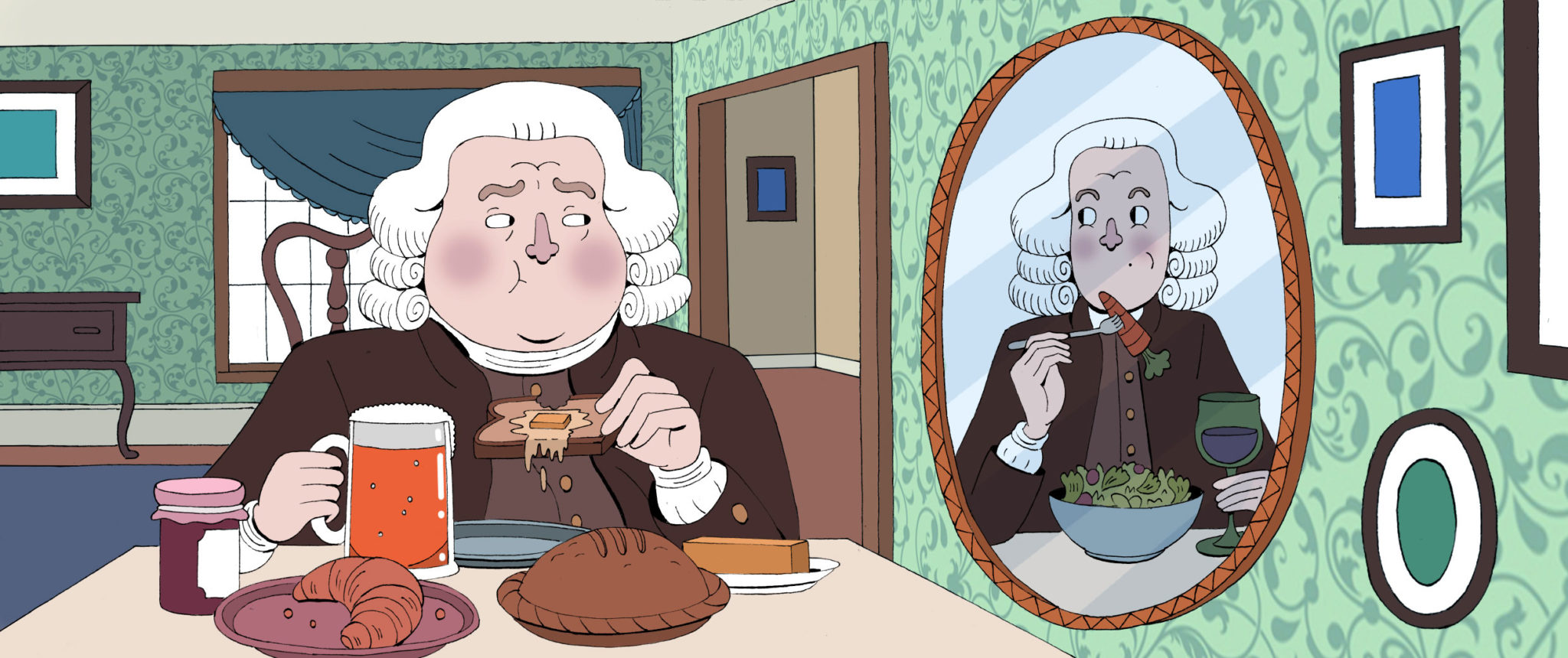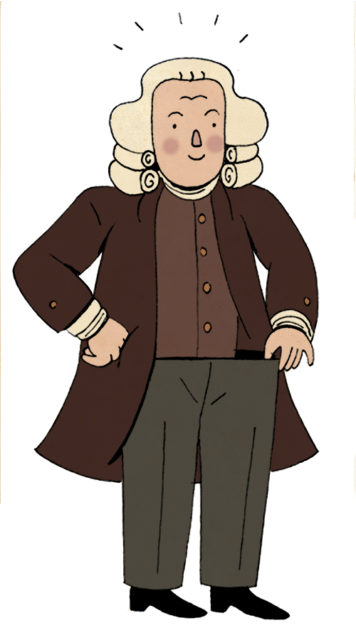William Banting tried every 19th century weight-loss fad, from caustic laxatives to vapor shampoos. Polite society was shocked when he unveiled the method that finally worked.
Betsy Golden Kellem

Illustrations by Ben Nadler.
In the fall of 1852, it seemed that all of London turned out in mourning dress for the funeral parade of Arthur Wellesley, the Duke of Wellington. The colossal procession, a long snake of black fabric, ostrich feathers and horseflesh, took four and a half hours to wind its way through the city streets, and no expense had been spared. Six thousand new gaslights were installed at St. Paul’s Cathedral for the occasion, and the body of the “Iron Duke” was carried on an ornate 10-ton funeral car studded with spears and streamers, his corpse nested in four coffins of pine, oak, lead and mahogany. Tennyson’s “Ode on the Death of the Duke of Wellington” sold like hotcakes for a shilling a copy, according to Cornelia D.J. Pearsall’s “Burying the Duke,” as a million people crowded roads and upper floors to catch a glimpse of the procession.
It was not just a funeral — it was an event. And it was all thanks to William Banting, a well-to-do London cabinetmaker and undertaker whose elaborate burials turned royal deaths into massive public spectacles. Banting, and his father before him, had prepared memorials for generations of British dignitaries, from King George to Lord Nelson, but despite the magnitude of these contributions to king and country, his name is remembered today not for the mahogany coffins and prancing stallions, but the fact that he became an unwitting diet guru.
Ten years after Wellington’s funeral, after a long career burying kings and statesmen, Banting found himself newly retired and deeply unhappy. This was because, in August of 1862, then in his mid-60s, he stood just shy of five and a half feet tall and weighed 202 pounds.
“Of all the parasites that affect humanity,” he wrote in his “Letter on Corpulence,” “I do not know of, nor can I imagine, any more distressing than that of Obesity.”
Banting’s frustrations seem all too familiar to many today who struggle with weight loss. No one in his family was inclined to be overweight, he noted, and he kept what he considered a reasonable level of physical activity. Noticing the number on the scale begin to creep up in his mid-30s, he consulted a doctor friend, who recommended some stout exercise. Neither willpower nor planning was a problem for a man who routinely organized royal ceremonials. Mr. Banting went to the Thames every morning and rowed his heart out in a good, steady boat, but while this caused him to gain strength and fitness, it also made him want to eat a horse.
“I was compelled to indulge,” Banting admitted, “and consequently increased in weight, until my kind old friend advised me to forsake the exercise.”
Banting tried every diet and lifestyle fad available in the middle 19th century: walks by the seaside to take in fresh air, caustic medicines and laxatives, “taking the waters” in favorable locations, Turkish baths, riding horseback, and so restricting his food intake that he likened it to living on pennies a day. One doctor advised “vapor-baths and shampooing” to work up a sweat.
Nothing seemed to swing the scale more than a few pounds, and at a time when trim gentlemen could be found in the press openly complaining about too many fat men on the London bus lines, the “sneers and remarks of the cruel and injudicious in public” couldn’t help but get through.
This wasn’t just a value judgment equating size with personal failure, either. In fact, Banting wrote, if a larger person managed to eat, drink and sleep well, and was free of pain or disease, more power to him. Most physicians considered gradual weight gain simply a part of the privilege of growing older in the 19th century. Banting, rather, felt he was being cut off from a full life, from access to public spaces and “advantages to health and comfort.”
By 1862, Banting was plainly in a bad way. He couldn’t reach his own shoes to tie them in the morning. Prone to light-headedness, he would go down stairs backward — wheezing and teetering slowly with each step — in order to minimize stress on his ankles and knees. He held in a painful hernia with a tight truss, and his vision and hearing were starting to suffer.
All of this changed when Banting visited Dr. William Harvey.
Harvey, an acquaintance of Charles Dickens’s, was then known as an ear surgeon. Banting was trying to get help with his hearing loss, and had not been scared away from doctors entirely despite the fact that his previous physician had treated the condition by sponging his ears internally, causing them to blister externally, and then promptly leaving town on vacation.
Harvey had recently attended a medical conference where the physician — Claude Bernard, known today for his work on the body’s natural state of equilibrium — had discussed metabolism as it might affect diabetes management. Inspired, Harvey decided to think beyond his patient’s ears.
Dr. Harvey urged his client to follow a new diet that de-emphasized starchy or sweet foods, which he believed tended to create fat. Banting, who was used to lavishly buttered toast, beer, meat and pastries on a regular daily rotation, grumbled that there would hardly be anything left in the world for him to eat, so the doctor drafted him a meal plan.
For breakfast, according to Banting’s “Letter,” Harvey recommended four or five ounces of meat or fish, unsweetened tea and a small bit of biscuit; for the largest meal at lunchtime, another serving of meat or fish, fruit and vegetables, some dry toast and poultry. Then three or four ounces of protein for dinner. Permitted snacks included fruit and tea, or the occasional rusk (a hard baked cracker along the lines of a baby’s teething biscuit). No champagne, port or beer was allowed, but — we are not barbarians, now! — Dr. Harvey encouraged Banting to enjoy a few glasses of sherry with his lunch and dinner, and even a nightcap of plain gin, whiskey or brandy.
The patient was delighted. Not only did Banting’s medical issues all improve, he began to sleep more soundly and watched the weight steadily come off. In a little more than year he lost 46 pounds, and would put on his old suit — 12 inches larger around the middle — to show his friends how much had changed. Gone were the boot hooks and knee braces, and the corset-like truss, too. Banting gladly paid Dr. Harvey’s bill and added an additional donation of £50 in gratitude, “for distribution amongst his favorite hospitals.”
Then Banting thought about how to share his good fortune with the public. He considered writing a letter to The Lancet medical journal or a popular magazine, but without the proper pedigree or introductions to recommend him, they were likely to toss it aside unread. He ultimately decided to self-publish a pamphlet entitled “Letter on Corpulence: Addressed to the Public.”
The pamphlet called obesity an increasing evil, “like the parasite of barnacles on a ship.” Describing his meal plan and clinical improvements in precise detail, Banting proclaimed himself “fully persuaded that hundreds, if not thousands, of our fellow men might profit equally by a similar course.” Just try the diet for a month, he urged skeptics, particularly “artists and men of sedentary employment who cannot spare time for exercise.”
The pamphlet was a runaway success, selling in the tens of thousands and causing the British public to use the infinitive “to bant” as a synonym for dieting.
Suddenly you couldn’t turn your head without hearing about this undertaker who wanted to promote longevity. The humor magazine Punch regularly cartooned Banting’s dietary strictures as a gag; an oddball farce called Doing Banting hit the English stage; and a popular song warned men about dieting too enthusiastically, with the narrator’s sweetheart clucking, “I hate thin men, you’re lost to me / if you persist in Banting.” An American paper cheerily proclaimed in the summer of 1864 that two Boston men had tried Banting’s method and lost more than 40 pounds each over the course of a year.
Colonialist Britain liked the idea of Banting’s plan, as well. This was, after all, the era of Muscular Christianity, a popular philosophy in Britain that fed imperial fervor with its insistence that English fortitude, Christian righteousness and a totally ripped bod walked hand in hand.
The 1885 text “Banting in India” cut straight to the chase, warning expats not to get too squishy around the middle, for the sake of the empire: “Effeminacy is associated with those crimes which have caused the everlasting downfall of nations.” The text made accommodations to the stock Banting diet for Westerners abroad, urging extra fluids during warm seasons, and swapping the rusks for a few spoonfuls of lentil dal.
Dr. Harvey, who had never intended to become a diet guru, was induced by the kerfuffle to write a book of his own on the subject in 1872. At more than a hundred pages long, it lacked the punch and emotional weight of Banting’s slim pamphlet; but the general thrust of Harvey’s therapy persists into modern health discourse, where it has become an evergreen diet fad.
Perhaps the largest takeaway for modern readers is that, in dieting terms, there’s little new under the sun. Regimens like Whole30 and Paleo are themselves revised versions of Atkins, which in turn tips its hat back to Banting. And in each generation that embraces the low-carb craze, there are commonalities, not least of which is that the same fanatic level of devotion and criticism has characterized each resurrection of the diet plan.
None of this seems unusual in the context of a highly media-savvy weight-loss industry that has now ballooned to more than $60 billion in volume in the United States alone. What is unusual is that, unlike many of the modern figures in the self-improvement market, for whom weight loss is very much a business, Banting refused to profit from his publications. He printed the first two editions of his diet pamphlet at his own cost and donated the profits to charity, taking out an advertisement in the London Morning Post to display an accounting.
Folks suggested (as they did in the 20th century with Robert Atkins) that William Banting was done in by the extremities of his own diet. In fact the former undertaker lived to the ripe old age of 81, killed not by any macronutrient, but a nasty case of bronchitis. Until that time, Banting assured pamphlet readers, he was in a “happy, comfortable state.” Classical wisdom may consider bread the “staff of life,” he acknowledged, but given the exchange of his aches and pains for a new, no doubt invigorating, stream of “flattering compliments,” he was more than happy to politely pass on the bread basket.